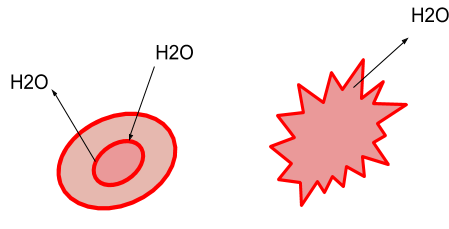
Answer
429.9k+ views
Hint: Tonicity is the concentration of a solution compared to another solution. Concentration describes the amount of solution dissolved.In biology, the tonicity of the environment as compared to the cell determines how water moves across the membrane.
Complete answer:
The graph illustrates the tonicity of different settings, and how water flows. To regulate the concentration gradient of solutes, water runs. It can switch from a high concentration of solute to a low concentration of solute. Three concepts, hypertonic, hypotonic, and isotonic, determine whether a solution allows water to pass into or out of a cell.
During a hypertonic solution, if a cell is put, there will be a net flow of water from the cell, and thus the cell will lose volume. If the solute concentration is greater than that within the cell, solutions are hypertonic to a cell, and hence the solutes do not cross the membrane.
There would be a net flow of water into the cell if a cell is put in a highly hypotonic solution, and the cell will thus gain volume. If the concentration of the solutes outside the cell is less than inside the cell and the solutes are also unable to cross the membrane, the solution is hypotonic to the cell.
There will be no net flow of water into or out of the cell if a cell is put in an isosmotic solution, and the volume of the cell will therefore remain constant. If the concentration of the solution outside the cell is the same as within the cell and the solutes are unable to cross the membrane as well, then the solution is isotonic to the cell.
During a hypertonic solution, if a cell is put, water will exit the cell, and thus the cell will shrink. There's no net water movement in an isotonic setting, so there is no change in the size of the cell. Water will enter the cell when a cell is put in a very hypotonic environment, and the cell will swell as well.
Note: Isotonic conditions are optimum in the case of a red blood corpuscle, and our body has homeostatic (stability-maintaining) mechanisms to confirm that these conditions remain stable. A red blood corpuscle, if put during a hypotonic solution, will bloat up and burst, while it will shrink in an extremely hypertonic solution, making the cytoplasm dense and its contents concentrated, and will die.
Complete answer:
The graph illustrates the tonicity of different settings, and how water flows. To regulate the concentration gradient of solutes, water runs. It can switch from a high concentration of solute to a low concentration of solute. Three concepts, hypertonic, hypotonic, and isotonic, determine whether a solution allows water to pass into or out of a cell.
During a hypertonic solution, if a cell is put, there will be a net flow of water from the cell, and thus the cell will lose volume. If the solute concentration is greater than that within the cell, solutions are hypertonic to a cell, and hence the solutes do not cross the membrane.
There would be a net flow of water into the cell if a cell is put in a highly hypotonic solution, and the cell will thus gain volume. If the concentration of the solutes outside the cell is less than inside the cell and the solutes are also unable to cross the membrane, the solution is hypotonic to the cell.
There will be no net flow of water into or out of the cell if a cell is put in an isosmotic solution, and the volume of the cell will therefore remain constant. If the concentration of the solution outside the cell is the same as within the cell and the solutes are unable to cross the membrane as well, then the solution is isotonic to the cell.
During a hypertonic solution, if a cell is put, water will exit the cell, and thus the cell will shrink. There's no net water movement in an isotonic setting, so there is no change in the size of the cell. Water will enter the cell when a cell is put in a very hypotonic environment, and the cell will swell as well.
Note: Isotonic conditions are optimum in the case of a red blood corpuscle, and our body has homeostatic (stability-maintaining) mechanisms to confirm that these conditions remain stable. A red blood corpuscle, if put during a hypotonic solution, will bloat up and burst, while it will shrink in an extremely hypertonic solution, making the cytoplasm dense and its contents concentrated, and will die.
Recently Updated Pages
Fill in the blanks with suitable prepositions Break class 10 english CBSE

Fill in the blanks with suitable articles Tribune is class 10 english CBSE

Rearrange the following words and phrases to form a class 10 english CBSE

Select the opposite of the given word Permit aGive class 10 english CBSE

Fill in the blank with the most appropriate option class 10 english CBSE

Some places have oneline notices Which option is a class 10 english CBSE

Trending doubts
Fill the blanks with the suitable prepositions 1 The class 9 english CBSE

How do you graph the function fx 4x class 9 maths CBSE

When was Karauli Praja Mandal established 11934 21936 class 10 social science CBSE

Which are the Top 10 Largest Countries of the World?

What is the definite integral of zero a constant b class 12 maths CBSE

Why is steel more elastic than rubber class 11 physics CBSE

Distinguish between the following Ferrous and nonferrous class 9 social science CBSE

The Equation xxx + 2 is Satisfied when x is Equal to Class 10 Maths

Differentiate between homogeneous and heterogeneous class 12 chemistry CBSE





